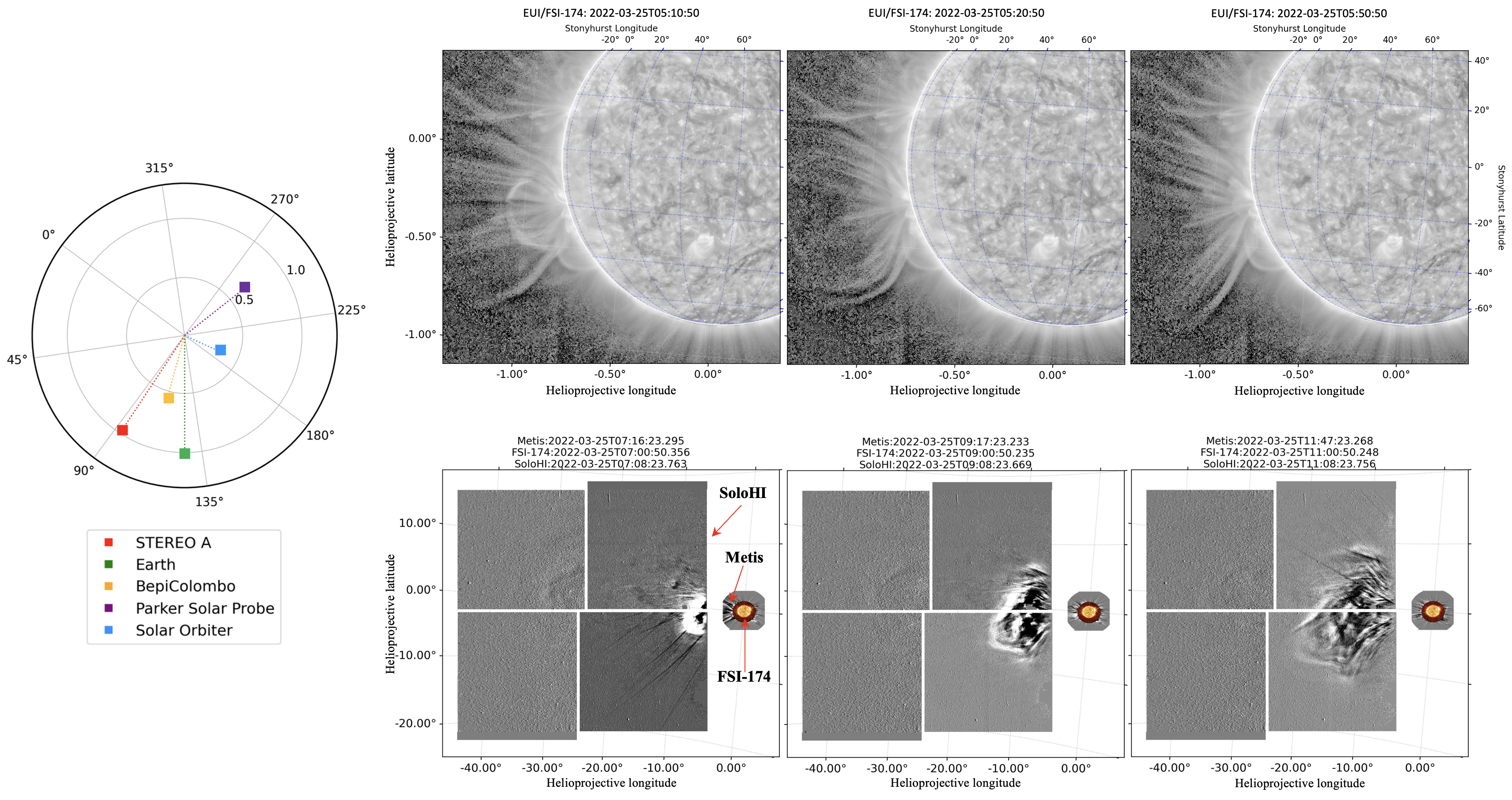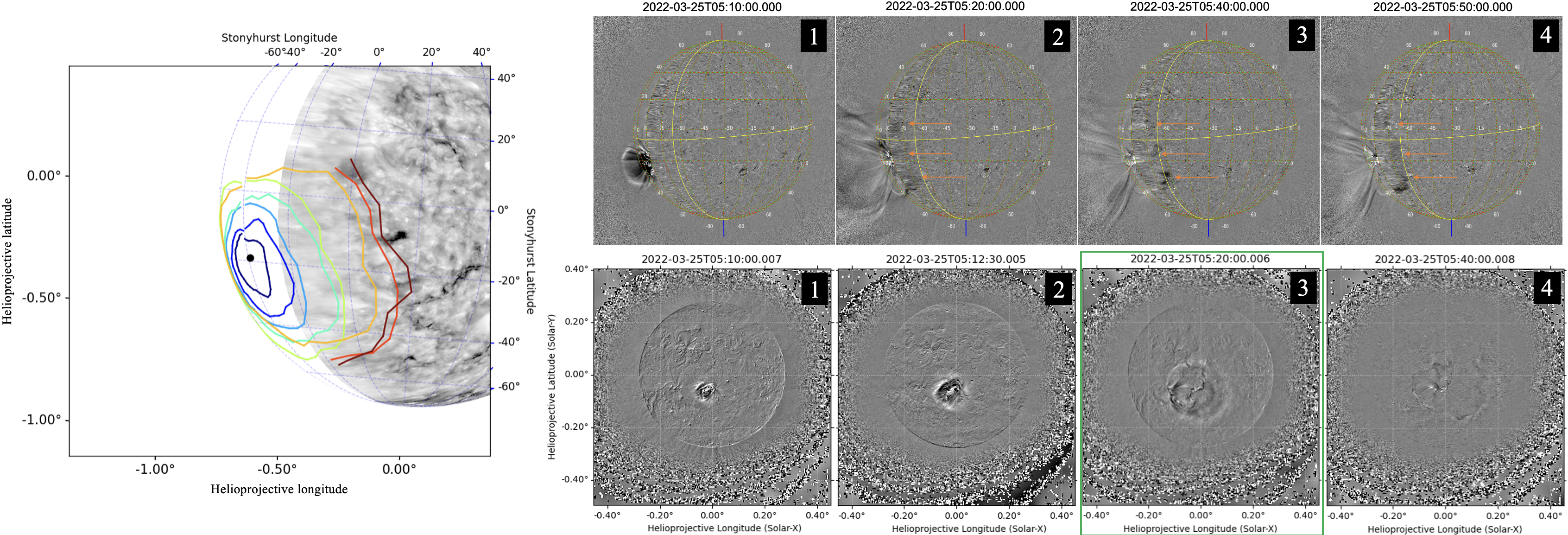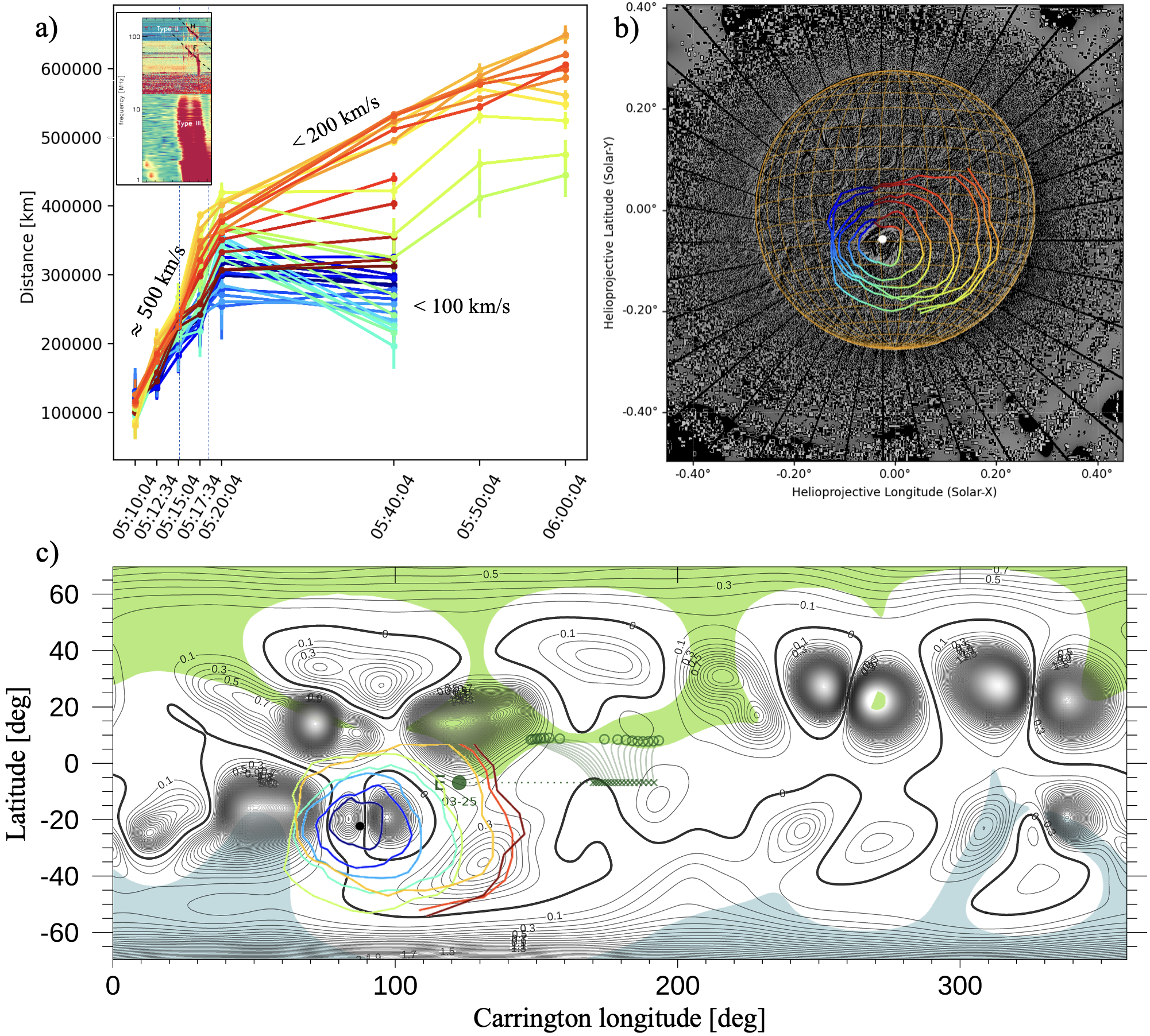Science nugget: Multi-Spacecraft Observations of the 2022 March 25 CME and EUV Wave: An Analysis of their Propagation and Interrelation - Solar Orbiter
Multi-Spacecraft Observations of the 2022 March 25 CME and EUV Wave: An Analysis of their Propagation and Interrelation
(Solar Orbiter nugget #23 by A. Liberatore1, P. C. Liewer1, A. Vourlidas2, C. R. Braga3, M. Velli4,5,1, O. Panasenco6, D. Telloni7, and S. Mancuso7)
Introduction
EUV waves are large-scale wave-like coronal disturbances visible in extreme ultraviolet (EUV) light [1]. EUV waves arise from active regions (ARs) and are almost always associated with Coronal Mass Ejections (CMEs) [2]. The nature of EUV waves and their interrelation with CMEs is still debated [3,4]. In the following, we investigate the nature of these phenomena through a multi-spacecraft analysis of an EUV wave associated with a CME observed on 2022 March 25. At that time Solar Orbiter (SolO) was at its first close perihelion and in near quadrature with the Solar Terrestrial Relations Observatory (STEREO-A).

Figure 1. Left: Relative position of the spacecraft on March 25, 2022 at 05:00 am UTC [5]. STEREO-A (red square) and Solar Orbiter (blue square) are near quadrature. Right: Selection of frames showing the CME evolution as observed by SolO/FSI-174 (top, initial phases), and by combing SolO/FSI-174 + Metis + SoloHI (bottom, interplanetary evolution).
Observation of the 2022 March 25 CME and EUV wave
On 2022 March 25 at 05:00 UTC multiple spacecraft observed a CME originating from AR 12974. SolO followed the CME during its entire evolution from the low corona to large heliocentric distances (> 55 R⊙) by combining three remote sensing instruments on board (Figure 1): the Full Sun Imager (FSI-174) [6], the coronagraph Metis [7], and the Solar Orbiter Heliospheric Imager (SoloHI) [8].
During the evolution of this CME, both STEREO-A/Extreme Ultraviolet Imager (EUVI-195) and SolO/FSI-174 observed a EUV wave propagating away from the same AR (Figure 2). Because the AR is almost at the center of the solar disk as observed by STEREO-A/EUVI, we were able to trace the evolution of the EUV wavefront at various position angles through a “point-and-click” method.

Figure 2. The image on the left shows the propagation of the EUV wavefront (as observed by EUVI) in the FSI field of view. Top: EUV wave (orange arrows) as observed by SolO/FSI-174. Each image is the difference between two consecutive frames. Due to the different wavelength, the EUV wave is not as clearly visible as in EUVI-195. However, it is possible to clearly observe the front of the CME in its early stage (not visible by STEREO or other spacecraft). Bottom: Selection of frames showing the EUV wave evolution as observed by STEREO-A/EUVI-195. Each frame is processed via a wavelet filter [9,10] and subtracted by the previous one. The EUV wave starts between 05:02:50 and 05:05:00 UTC and is visible until ≈ 06:00:00 UTC with a temporal resolution of 2.5 minutes (An animation of this figure is available).
EUV wave - CME propagation and interrelation
[3] reviews various interpretations of the nature of EUV waves as pseudo-waves, magneto-hydrodynamic (MHD) waves, or hybrid (i.e., a combination of the previous ones). The pseudo-wave interpretation suggests that EUV waves are the disk projection of the CME’s expanding envelope and not a true wave phenomenon [11]. The fast-/slow-mode MHD wave mode speeds can be described by the following equation:

where vA = local Alfven speed, cs = sound speed, and θ = inclination between wave vector and magnetic field. The slow-mode phase velocity (vs) has a strong dependence on the propagation angle and goes to zero at θ = 90° (i.e., it cannot propagate perpendicularly to the magnetic field lines). For this reason, and considering the large scales of these phenomena, this interpretation is often rejected. Eq. 1 shows also that a fast magnetosonic wave must have a speed > vA. Another interpretation is given by [12] and [13]: EUV waves can be interpreted as waves initially driven by a fast lateral expansion of the CME, then transitioning to a fast magnetosonic wave, at a lower velocity, after the rapid initial expansion slows. The observation of this kinematic behavior is almost impossible without high cadence imaging since the initial high-speed propagation and the decoupling phase tend to develop within 5 mins or so.
The strategic position between SolO and STEREO-A, and the high cadence of the EUVI acquisitions (2.5 minutes) allows us to compare, frame-by-frame, the CME and EUV wave early phase evolution to deconstruct the nature of the wave and its interrelation with the CME.
The kinematics study of the EUV wave, derived via visual identification of the fronts using the STEREO-A data, shows a change in velocity at about 05:20 UTC (Figure 3a). At that time, FSI images show the last fast lateral expansion of the CME (Figure 1 top, and Figure 2 top). At the same moment, the EUV wave shows a double front (green square in Figure 2 bottom). These two fronts may be an indication of the decoupling moment between the expanding CME and EUV wave as suggested by [12] and [13]. Additional insights come from the Type II radio burst associated to this event. The expanding CME caused a type II radio emission [14,15]. When the expansion slows (≈ 05 : 20 UTC), the radio emission stops, and at the same time, the EUV wave becomes freely propagating.
Finally, comparing the EUV speed to the local magnetic field using standard models of the solar corona, we can notice how the EUV wave, once free to propagate, avoids strong magnetic field regions. This behavior is consistent with a fast-mode magnetosonic wave.

Figure 3. a-b): Evolution of the EUV wave front in time (a) and space (b). Different colors are different position angles. The right image (b) shows the front projected on an EUVI-195 image at a fixed time. A type II radio burst is observed in the range of time delimited by the two dotted vertical lines in the time-distance plot (a). c): EUV wavefront evolution observed on a Carrington map showing the contour of magnetic field strength calculated from a Potential Field Source Surface model for 2022 March 25 at 12:04 UTC, 1.2R⊙; Rss = 2.5. Different colors correspond to different times. The wave avoids strong magnetic field regions (top and top left regions) while being free to propagate through the low field regions (right-side regions).
Conclusion and Discussion
In this work we investigated the nature of EUV waves in relation to the CME evolution through the analysis of the multi-spacecraft remote sensing observations of the 2022 March 25 CME-EUV wave event. We performed a detailed analysis of this event making use of the strategic relative position of SolO and STEREO-A (near quadrature). The large amount of evidence summarized in this study (i.e., imaging, kinematic, radio analysis, comparison with B, etc.), gives further support to the hybrid interpretation of EUV waves proposed by [3] and [13].
Movie 1. The Stereo-A data clearly displaying the EUV wave discussed here.
This study has been published in Alessandro Liberatore, et al. 2023 ApJ, 957, 110 https://doi.org/10.3847/1538-4357/acf8bf
Acknowledgements
The work of A.L. and P.C.L. was conducted at the Jet Propulsion Laboratory, California Institute of Technology under a contract from NASA (80NM0018D0004). A.V. is supported by NASA grants 80NSSC22K1028 and 80NSSC22K0970. C.R.B. acknowledges the support from the NASA STEREO/SECCHI (NNG17PP27I) program and NASA HGI (80NSSC23K0412) grant. M.V. was supported by ISSI via the J. Geiss fellowship and NASA contracts NNN06AA01C and the NASA Parker Solar Probe Observatory Scientist grant NNX15AF34G.
Affiliations
1 Jet Propulsion Laboratory, California Institute of Technology, Pasadena, CA 91109, USA
2 The Johns Hopkins University Applied Physics Laboratory, Laurel, MD 20723, USA
3 George Mason University, Fairfax, VA 22030, USA
4 Department of Earth, Planetary, and Space Sciences, University of California, Los Angeles, CA, 90095 USA
5 International Space Science Institute, 3012 Bern, Switzerland
6 Advanced Heliophysics, Pasadena, CA 91106, USA
7 National Institute for Astrophysics, Astrophysical Observatory of Turin, 10025, Pino To.se, Turin, Italy
References
[1] Thompson, B. J., Gurman, J. B., Neupert, W. M., et al. 102 1999, The Astrophysical Journal Letters, 517, L151, https://doi.org/10.1086/312030
[2] Cliver, E. W., Laurenza, M., Storini, M., & Thompson, B. J. 2005, The Astrophysical Journal, 631, 604, https://doi.org/10.1086/432250
[3] Patsourakos, S., & Vourlidas, A. 2012, SoPh, 281, 187, https://doi.org/10.1007/s11207-012-9988-6
[4] Warmuth, A. 2015, Living Reviews in Solar Physics, 12, 3, 105 https://doi.org/10.1007/lrsp-2015-3
[5] Gieseler, J., Dresing, N., Palmroos, C., et al. 2023, Frontiers in Astronomy and Space Sciences, 9, https://doi.org/10.3389/fspas.2022.1058810
[6] Rochus, P., Auchere, F., Berghmans, D., et al. 2020, A&A, 642, A8, https://doi.org/10.1051/0004-6361/201936663
[7] Antonucci, E., Romoli, M., Andretta, V., et al. 2020, A&A, 642, A10, https://doi.org/10.1051/0004-6361/201935338
[8] Howard, R. A., Vourlidas, A., Colaninno, R. C., et al. 2020, 88 A&A, 642, A13, https://doi.org/10.1051/0004-6361/201935202
[9] Stenborg, G., Vourlidas, A., & Howard, R. A. 2008, ApJ, 674, 1201, https://doi.org/10.1086/525556
[10] Raouafi, N. E., & Stenborg, G. 2014, ApJ, 787, 118, https://doi.org/10.1088/0004-637X/787/2/118
[11] Delannee, C., & Aulanier, G. 1999, SoPh, 190, 107, https://doi.org/10.1023/A:1005249416605
[12] Patsourakos, S., & Vourlidas, A. 2009, The Astrophysical 92 Journal, 700, L182, https://doi.org/10.1088/0004-637X/700/2/L182
[13] Kienreich, I. W., Temmer, M., & Veronig, A. M. 2009, ApJL, 703, L118, https://doi.org/10.1088/0004-637X/703/2/L118
[14] Cairns, I. H., & Robinson, R. D. 1987, SoPh, 111, 365, https://doi.org/10.1007/BF00148526
[15] Bale, S. D., Reiner, M. J., Bougeret, J.-L., et al. 1999, Geophys. Res. Lett., 26, 1573, https://doi.org/10.1029/1999GL900293
- Removed a total of (4) style margin:0;
Nuggets archive
2025
09/04/2025: Bursty acceleration and 3D trajectories of electrons in a solar flare
02/04/2025: Picoflare jets in the coronal holes and their link to the solar wind
19/03/2025: Radial dependence of solar energetic particle peak fluxes and fluences
12/03/2025: Analysis of solar eruptions deflecting in the low corona
05/03/2025: Propagation of particles inside a magnetic cloud: Solar Orbiter insights
19/02/2025: Rotation motions and signatures of the Alfvén waves in a fan-spine topology
12/02/2025: 'Sun'day everyday: 2 years of Solar Orbiter science nuggets that shed light on some of our star's mysteries
22/01/2025: Velocity field in the solar granulation from two-vantage points
15/01/2025: First joint X-ray solar microflare observations with NuSTAR and Solar Orbiter/STIX
2024
18/12/2024: Shocks in tandem : Solar Orbiter observes a fully formed forward-reverse shock pair in the inner heliosphere
11/12/2024: High-energy insights from an escaping coronal mass ejection
04/12/2024: Investigation of Venus plasma tail using the Solar Orbiter, Parker Solar Probe and Bepi Colombo flybys
27/11/2024: Testing the Flux Expansion Factor – Solar Wind Speed Relation with Solar Orbiter data
20/11/2024:The role of small scale EUV brightenings in the quiet Sun coronal heating
13/11/2024: Improved Insights from the Suprathermal Ion Spectrograph on Solar Orbiter
30/10/2024: Temporally resolved Type III solar radio bursts in the frequency range 3-13 MHz
23/10/2024: Resolving proton and alpha beams for improved understanding of plasma kinetics: SWA-PAS observations
25/09/2024: All microflares that accelerate electrons to high-energies are rooted in sunspots
25/09/2024: Connecting Solar Orbiter and L1 measurements of mesoscale solar wind structures to their coronal source using the Adapt-WSA model
18/09/2024: Modelling the global structure of a coronal mass ejection observed by Solar Orbiter and Parker Solar Probe
28/08/2024: Coordinated observations with the Swedish 1m Solar Telescope and Solar Orbiter
21/08/2024: Multi-source connectivity drives heliospheric solar wind variability
14/08/2024: Composition Mosaics from March 2022
19/06/2024: Coordinated Coronal and Heliospheric Observations During the 2024 Total Solar Eclipse
22/05/2024: Real time space weather prediction with Solar Orbiter
15/05/2024: Hard X ray and microwave pulsations: a signature of the flare energy release process
01/02/2024: Relativistic electrons accelerated by an interplanetary shock wave
11/01/2024: Modelling Two Consecutive Energetic Storm Particle Events observed by Solar Orbiter
2023
14/12/2023: Understanding STIX hard X-ray source motions using field extrapolations
16/11/2023: EUI data reveal a "steady" mode of coronal heating
09/11/2023: A new solution to the ambiguity problem
02/11/2023: Solar Orbiter and Parker Solar Probe jointly take a step forward in understanding coronal heating
25/10/2023: Observations of mini coronal dimmings caused by small-scale eruptions in the quiet Sun
18/10/2023: Fleeting small-scale surface magnetic fields build the quiet-Sun corona
27/09/2023: Solar Orbiter reveals non-field-aligned solar wind proton beams and its role in wave growth activities
20/09/2023: Polarisation of decayless kink oscillations of solar coronal loops
23/08/2023: A sharp EUI and SPICE look into the EUV variability and fine-scale structure associated with coronal rain
02/08/2023: Solar Flare Hard Xrays from the anchor points of an eruptive filament
28/06/2023: 3He-rich solar energetic particle events observed close to the Sun on Solar Orbiter
14/06/2023: Observational Evidence of S-web Source of Slow Solar Wind
31/05/2023: An interesting interplanetary shock
24/05/2023: High-resolution imaging of coronal mass ejections from SoloHI
17/05/2023: Direct assessment of far-side helioseismology using SO/PHI magnetograms
10/05/2023: Measuring the nascent solar wind outflow velocities via the doppler dimming technique
26/04/2023: Imaging and spectroscopic observations of EUV brightenings using SPICE and EUI on board Solar Orbiter
19/04/2023: Hot X-ray onset observations in solar flares with Solar Orbiter/STIX
12/04/2023: Multi-scale structure and composition of ICME prominence material from the Solar Wind Analyser suite
22/03/2023: Langmuir waves associated with magnetic holes in the solar wind
15/03/2023: Radial dependence of the peak intensity of solar energetic electron events in the inner heliosphere
08/03/2023: New insights about EUV brightenings in the quiet sun corona from the Extreme Ultraviolet Imager








































 Sign in
Sign in
 Science & Technology
Science & Technology